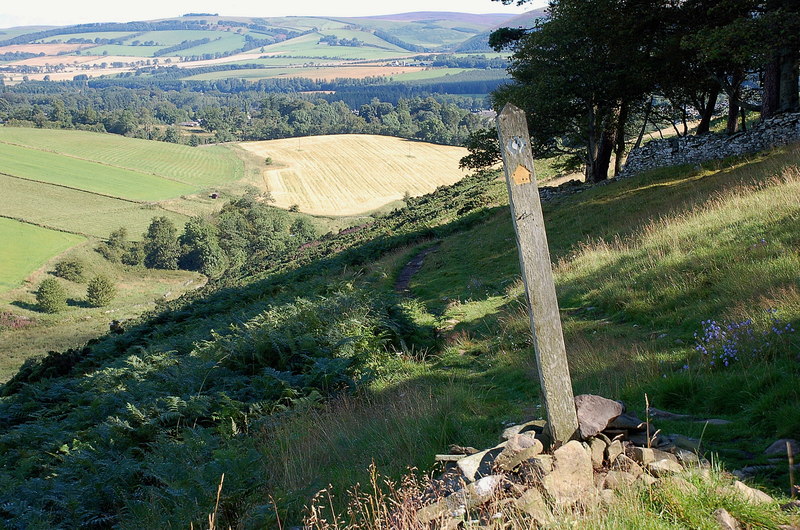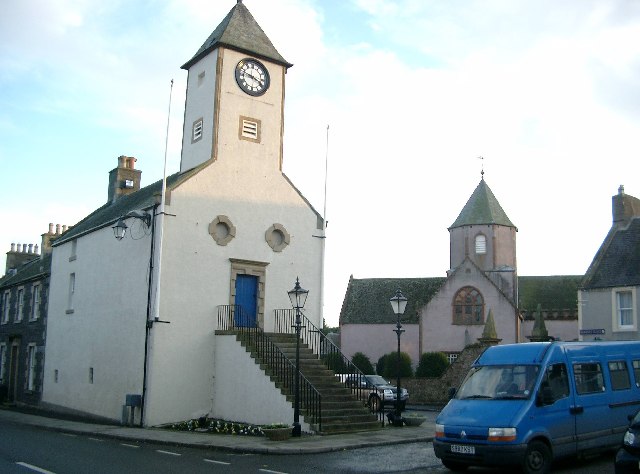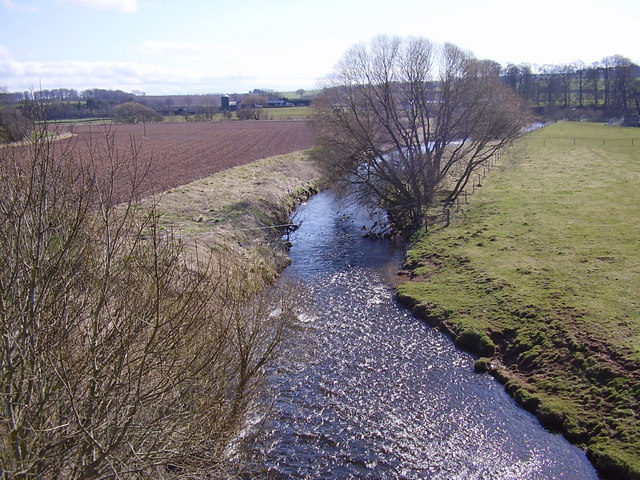|
Lauderdale
Lauderdale is the valley of the Leader Water (a tributary of the Tweed) in the Scottish Borders. It contains the town of Lauder, as well as Earlston. The valley is traversed from end to end by the A68 trunk road, which runs from Darlington to Edinburgh. Roman road Many ancient camps, and many ''tumuli'', are found in Lauderdale. The Roman road into Scotland, Dere Street, which means "the road into the country of the wild animals", crossed a ford at Newstead, near Melrose, where there had been a Roman fort and garrison, and entered Lauderdale. Dere Street is said to have been reconditioned by King Malcolm Canmore and probably used by him in his almost constant warfare against England. The Roman road has now been traced from the Tweed through Lauderdale to Soutra. Etymology Lauderdale's name comes from the town of Lauder rather than the Leader Water. The relationship between the names "Leader" and "Lauder" is very obscure; despite their similarity, they may have different o ... [...More Info...] [...Related Items...] OR: [Wikipedia] [Google] [Baidu] |
Lauder
The former Royal Burgh of Lauder (, gd, Labhdar) is a town in the Scottish Borders in the historic county of Berwickshire. On the Southern Upland Way, the burgh lies southeast of Edinburgh, on the western edge of the Lammermuir Hills. Etymology Although Lauder sits in the valley of Leader Water, Watson notes that the names Lauder and Leader appear to be unconnected. In the earliest sources Lauder appears as ''Lawedder'' and ''Loweder''. The name may be derived from the Brittonic ''lǭwadr'', meaning "washing or bathing place" ( Breton ''laouer''). Or else, Lauder may be named from a word related to Middle Welsh ''llawedrawr'', "a heap of ruins". Medieval history Below Lauder are the lands of Kedslie which were bounded on the west by a road called "Malcolm's rode", and it is thought this formed part of the Roman road known as Dere Street, which passed through Lauder. Hardie suggests that it had been reconditioned by Malcolm III for use in his almost constant warfare again ... [...More Info...] [...Related Items...] OR: [Wikipedia] [Google] [Baidu] |
Scottish Borders
The Scottish Borders ( sco, the Mairches, 'the Marches'; gd, Crìochan na h-Alba) is one of 32 council areas of Scotland. It borders the City of Edinburgh, Dumfries and Galloway, East Lothian, Midlothian, South Lanarkshire, West Lothian and, to the south-west, south and east, the English counties of Cumbria and Northumberland. The administrative centre of the area is Newtown St Boswells. The term Scottish Borders, or normally just "the Borders", is also used to designate the areas of southern Scotland and northern England that bound the Anglo-Scottish border. Geography The Scottish Borders are in the eastern part of the Southern Uplands. The region is hilly and largely rural, with the River Tweed flowing west to east through it. The highest hill in the region is Broad Law in the Manor Hills. In the east of the region, the area that borders the River Tweed is flat and is known as 'The Merse'. The Tweed and its tributaries drain the entire region with the river fl ... [...More Info...] [...Related Items...] OR: [Wikipedia] [Google] [Baidu] |
Hugh De Morville, Constable Of Scotland
Hugh de Morville (died 1162) of Appleby in Westmorland, England, hereditary Constable of Scotland, was a Norman knight who made his fortune in the service of David FitzMalcolm (d.1153), Prince of the Cumbrians, later King of Scotland. Origins Hugh came from Morville in the Cotentin Peninsula, in northern France. His parentage is unclear. According to Barrow his father was probably Richard de Morville who in the early twelfth century witnessed charters made by Richard de Redvers relating to Montebourg and the church of St. Mary in the castle of Néhou, but though Keats-Rohan gives that man other possible sons, she does not similarly associate Hugh with Richard. In service of David of Scotland Prince David of Scotland held Cotentin in northern France, given to him by King Henry I of England some time after 1106. Soon after, Hugh de Morville joined David's small military retinue in France. In 1113, following his marriage, Prince David was made Earl of Huntingdon and Nort ... [...More Info...] [...Related Items...] OR: [Wikipedia] [Google] [Baidu] |
Earlston
Earlston ( sco, Yerlston; gd, Dùn Airchill) is a civil parish and market town in the county of Berwickshire, within the Scottish Borders. It is on the River Leader in Lauderdale, Scotland. Early history Earlston was originally called ''Arcioldun'' or ''Prospect Fort'', with reference to Black Hill (), on the top of which can still be traced the concentric rings of the British fort for which it was named. It is also said to be possible to make out the remains of the cave-dwellings of the Votadini, the tribal confederation in this part of Scotland. In the 12th and 13th centuries the Lindsays and the Earls of March and Dunbar were the chief baronial families. Also of historical interest is the ivy-clad ruin of the ''Rhymer's Tower'', a keep said to date from as early as the 13th century. It is the traditional residence of Thomas Learmonth, commonly called Thomas of Ercildoune, or Thomas the Rhymer, poet, prophet, and legendary friend of the Elves, who was born here about 1 ... [...More Info...] [...Related Items...] OR: [Wikipedia] [Google] [Baidu] |
Alan Of Galloway
Alan of Galloway (before 1199 – 1234), also known as Alan fitz Roland, was a leading thirteenth-century Scottish magnate. As the hereditary Lord of Galloway and Constable of Scotland, he was one of the most influential men in the Kingdom of Scotland and Irish Sea zone. Alan first appears in courtly circles in about 1200, about the time he inherited his father's possessions and offices. After he secured his mother's inheritance almost two decades later, Alan became one of the most powerful magnates in the Scottish realm. Alan also held lands in the Kingdom of England, and was an advisor of John, King of England concerning ''Magna Carta''. Alan later played a considerable part in Alexander II, King of Scotland's northern English ambitions during the violent aftermath of John's repudiation of ''Magna Carta''. Alan participated in the English colonisation of Ulster, receiving a massive grant in the region from the English king, and simultaneously aided the Scottish crown against ... [...More Info...] [...Related Items...] OR: [Wikipedia] [Google] [Baidu] |
Newstead, Scottish Borders
Newstead is a village in the Scottish Borders, about east of Melrose. It has a population of approximately 260, according to the 2001 census. Location and history It is situated in the valley of the River Tweed, at a crossing point for the Roman Dere Street. Newstead was of great strategic importance throughout history. This was principally due to the proximity of the prominent Eildon Hill. Former inhabitants include: the ancient Selgovae; the Roman army at Trimontium (Newstead); monks and masons, builders of nearby Melrose Abbey and, more recently, navvies working on the impressive railway viaduct at Leaderfoot. It is reputedly the oldest continually-inhabited settlement in Scotland. Certainly buildings, inhabited by the locals who provided for the needs of the soldiers when the Romans were there, and that the people who remained when the Romans went back south continued to live there, and that a population is recorded there from 650 AD onwards, until the present da ... [...More Info...] [...Related Items...] OR: [Wikipedia] [Google] [Baidu] |
Melrose, Scotland
Melrose ( gd, Maolros, "bald moor") is a small town and civil parish in the Scottish Borders, historically in Roxburghshire. It lies within the Eildon committee area of Scottish Borders Council. History The original Melrose was ''Mailros'', meaning "the bare peninsula" in Old Welsh or Brythonic. This referred to a neck of land by the River Tweed several miles east of the present town, where in the 6th century a monastery was founded associated with St Cuthbert. It was recorded by Bede, and also in the Anglo-Saxon Chronicle with the name ''Magilros''. This monastery and settlement, later known as "Old Melrose", were long abandoned by the 12th century. King David I of Scotland took the throne in 1124, and sought to create a new Cistercian monastery on that site; however the monks preferred a site further west called "Fordel". So the monastery now known as Melrose Abbey was founded there in 1136, and the town of Melrose grew up on its present site around it. In the late Middle A ... [...More Info...] [...Related Items...] OR: [Wikipedia] [Google] [Baidu] |
Archibald Douglas, 4th Earl Of Douglas
Archibald Douglas, 4th Earl of Douglas, Duke of Touraine (c. 1369 – 17 August 1424), was a Scottish nobleman and warlord. He is sometimes given the epithet "Tyneman" (Old Scots: Loser), but this may be a reference to his great-uncle Sir Archibald Douglas. Master of Douglas The eldest legitimate son of Archibald Douglas, 3rd Earl of Douglas and Joanna de Moravia of Bothwell, he was born either at Threave Castle or at Bothwell Castle c. 1369 and was known as the ''Master of Douglas'' until his accession. By 1390 he had married the Princess Margaret of Carrick, a daughter of King Robert III of Scotland. Around this time, his father bestowed upon him the regalities of the Ettrick Forest, Lauderdale and Romannobridge, Peeblesshire. On 4 June 1400, King Robert appointed him Keeper of Edinburgh Castle for life, on a pension of 200 merks a year. Rites of Passage Renewal of the Percy/Douglas feud At Candlemas 1400 George I, Earl of March and Henry 'Hotspur' Percy had entere ... [...More Info...] [...Related Items...] OR: [Wikipedia] [Google] [Baidu] |
Leader Water
The River Leader, or Leader Water, is a small tributary of the River Tweed in Lauderdale in the Scottish Borders. It flows southwards from the Lammermuir Hills through the towns of Lauder and Earlston, joining the River Tweed at Leaderfoot. Course The feeder burns of the Leader Water are the Headshaw Burn, the Hillhouse Burn and the Kelphope Burn. They combine at the Carfrae mill hotel and the village of Oxton. The river is now sandwiched between the A68 and the A697, and it has absorbed the Cleekhimin Burn, Harry Burn, Washing Burn and Earnscleugh Burn. The Leader Water now passes to the east of the town of Lauder, by Thirlestane Castle. The A679 bridges the river which continues past Lauder Barns, West Mains and St. Leonards where the Leader receives his final feeder burn, the Boondreigh Burn. It now sticks closely by the A68, near the Whitslaid Tower, the Blainslies, Galadean, Birkhill, Chapel-on-Leader and Leadervale. After passing through the outskirts of Earlston, the ... [...More Info...] [...Related Items...] OR: [Wikipedia] [Google] [Baidu] |
Whitslaid Tower
Whitslaid Tower was an ancient Berwickshire seat of the Lauder family for over 300 years. It is today a ruin high above the eastern bank of the Leader Water, south of the burgh of Lauder, in the Scottish Borders. In feudal times it fell within a detached segment of the King's personal Barony of Renfrew. The tower It stands on an abrupt eminence, shaded with old ash trees, and behind it is a flat open space sufficient for a garden and the offices attached to the residence of a landowner in the ancient warlike times with which it is associated. An old dirt road winds round it in a gully leading north from the Leader Water, the whole immediate area being commanded by the fortress. The walls of this square pele are now in ruins. The huge vault on the ground floor remains largely intact and the turnpike stairs situated within the thick walls still takes one to the first floor level. The ceiling of the vault is of a quarried greywacke that splits into thin slabs, which are fitted e ... [...More Info...] [...Related Items...] OR: [Wikipedia] [Google] [Baidu] |
Lammermuir Hills
The Lammermuirs are a range of hills in southern Scotland, forming a natural boundary between East Lothian and the Borders. The name "Lammermuir" comes from the Old English ''lambra mōr'', meaning "moorland of the lambs". Geology The Lammermuir Hills are formed from a succession of Silurian and Ordovician age marine sediments known as greywackes together with siltstones, shales and mudstones. They are assigned to the Gala Group. Unconformably overlying these highly faulted and folded strata are outcrops of the early Devonian age Great Conglomerate Formation which forms a part of the Reston Group of Old Red Sandstone rocks. These coarse red-purple conglomerates underlie a band of country in the east between Longformacus and Oldhamstocks and also occur in an isolated outcrop east of Soutra Hill and beneath the Dun Law Wind Farm on the western margin of the hills. The same strata extend down Lauderdale on the western margin of the hills. Numerous dykes of diffe ... [...More Info...] [...Related Items...] OR: [Wikipedia] [Google] [Baidu] |
River Tweed
The River Tweed, or Tweed Water ( gd, Abhainn Thuaidh, sco, Watter o Tweid, cy, Tuedd), is a river long that flows east across the Border region in Scotland and northern England. Tweed cloth derives its name from its association with the River Tweed. The Tweed is one of the great salmon rivers of Britain and the only river in England where an Environment Agency rod licence is not required for angling. The river generates a large income for the local borders region, attracting anglers from all around the world. Etymology ''Tweed'' may represent an Old Brittonic name meaning "border". A doubtful proposal is that the name is derived from a non-Celtic form of the Indo-European root ''*teuha-'' meaning "swell, grow powerful". Course The River Tweed flows primarily through the scenic Borders region of Scotland. Eastwards from the settlements on opposing banks of Birgham and Carham it forms the historic boundary between Scotland and England. It rises in the Lowther Hill ... [...More Info...] [...Related Items...] OR: [Wikipedia] [Google] [Baidu] |







